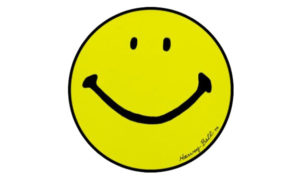
Inspiration for I Remember JFK comes from a variety of sources. One more or less constant provider of ideas is The History Channel. I was watching a show on the 70’s the other night and was intrigued by the origin and history of that enigmatic symbol of optimism: the smiley face.
The smiley face originated on the drawing table of one Harvey Ball, who was a freelance graphical artist in Worcester, MA. In 1963, the State Mutual Life Assurance Company hired him to design a logo that would raise company morale.
Ball sat down and designed a simple bright yellow smiling face in about ten minutes. The insurance company liked it, and Ball pocketed his $45 fee and forgot about it.
The insurance company produced 100 7/8″ button pins with the logo. They soon had to order thousands more. Morale was raised dramatically, and the smiley face became immensely popular among employees, customers, and their friends and family.
As time went on, the smiley face took on a life of its own. One thing that neither Ball nor State Mutual Life ever bothered to do was trademark the logo. Ball, in particular, would later come to rue that oversight.
The unauthorized commercialization of the smiley face began in the year that it was created. A syndicated children’s cartoon show called The Funny Company appeared in 1963. One of the series’ characters sported a smiley face logo on his hat.
As the 70’s began, the smiley face took off big time. In September, 1970, two enterprising ideamen named Bernard and Murray Spain took the smiley face logo and added the words “Have a nice day” underneath it. They then copyrighted the image and words.
The smiley face, now in control of the two Philadelphia brothers, soon began appearing on t-shirts, buttons, notebooks, bumper stickers, and practically everywhere else that an image could be printed. Kids in my school who used to sport peace signs were now seen wearing the ubiquitous smiley face.
Ball didn’t pay a lot of attention to his creation’s usage. If anything, he was pleased with the “feel-goodedness” that it promoted among its wearers.

Two years after its introduction, the smiley face fad was passe. But the optimistic icon never disappeared completely. Some chose to dot their handwritten i’s with a smiley face. Others continued to wear their smiley face t-shirts despite its no longer being cool, and demand remained high enough that smiley face merchandise continued to be sold in modest numbers.
In 1996, the smiley face began its ultimate commercialization. Retail giant Walmart began using the logo in its stores, and soon afterwards on TV ads. Eventually, the behemoth tried to take over ownership of Ball’s design through court action, but was stymied primarily by a Frenchman who claimed that he had laid claim to the logo’s copyright in 1971. I couldn’t find any mention of the Spain brothers in the litigation.
The trial (which Walmart lost) took place in 2006. But Ball had years earlier grown disgusted with the commercialization of his creation by the time he saw Walmart and others using it to hawk products. So in 1999, he formed the World Smile Corporation in an attempt to bring the focus back to the message behind the logo: spreading good will and good cheer.
Ball died in 2001, but he might be satisfied in knowing that despite the fact that many people have made many millions from the logo that he never bothered to register as a trademark, it continues to make countless people feel just slightly better and more friendly after encountering it on a t-shirt, coffee mug, or what-have-you.